
The year 1896 saw not only the first modern Olympics, but also the first athletic competitions (운동회) in Korea. These sports competitions were the dawn of Korean sports. This “Dawn” would have been unimaginable several decades earlier because the country was dominated by a Confucian elite who tended to hold all physical activities in low regard, including the martial arts. King Kojong played a critical role in transforming Korea into a modern nation-state. His “Rescript on National Education” 교육조서 (敎育詔書), issued on Feb. 2, 1895, formally recognized the three principles of education including moral, physical, and intellectual education. An increasing number of Koreans began to play “sports”.
Under Japanese colonial rule (1910–1945), Korea remained obscure to the rest of the world, but the interest of many Koreans in the (world) Olympics and their desire for Korean participation was growing. In the 1920s, Japanese colonial policies in Korea became more favorable to Korean sports. The Governor General of Korea gave permission for the formation of civil organizations. Korean-led organizations began popping up throughout the peninsula at a phenomenal rate. From only 985 organizations in 1920, they grew to 5,728 by September 1922. Korean athletes participated in the 1932 Summer, 1936 Winter, and 1936 Summer Games as part of the Japanese delegation. These athletes attracted significant attention from all walks of life in colonial Korea. The Korean media generated an Olympic boom that appealed to both nationalistic and commercial interests. Sports served as a powerful vehicle for Koreans to channel their nationalistic sentiment into an independence movement, as the Japanese colonial power structure overtly stifled all anti-Japanese movements. In colonial Korea, sports stadiums symbolized a battlefield for the Korean people’s anti-colonial struggle. Those Koreans who were part of the diaspora into Manchuria, China proper, Japan, and the United States were among some of the most enthusiastic supporters of the Korean athletes. Even so, a large segment of the Korean-American population did not embrace the three Korean athletes who competed in the 1932 Los Angeles Olympics. Their presence, under the Japanese flag, was not a sign of national glory but of national shame.
Chosŏn Sports Association
There is a great deal of confusion when researching the Chosŏn Sports Association because the Japanese established their Chosŏn Sports Association 조선체육협회 (朝鮮體育協會) on Feb. 18, 1919 and the Koreans established their Chosŏn Sports Association 조선체육회 (朝鮮體育會) on July 13, 1920. On some sports medals, the Japanese controlled Chosŏn Sports Association inscription is rendered as 朝鮮体育協會. Today, the (Korean) Chosŏn Sports Association is commonly called the Chosŏn Sports Council (CSC) or the Chosŏn Athletic Association. The Chosŏn Shrine Games were held under the auspices of the (Japanese) Chosŏn Sports Association, while the All Chosŏn Games were held under the auspices of the (Korean) Chosŏn Sports Association.
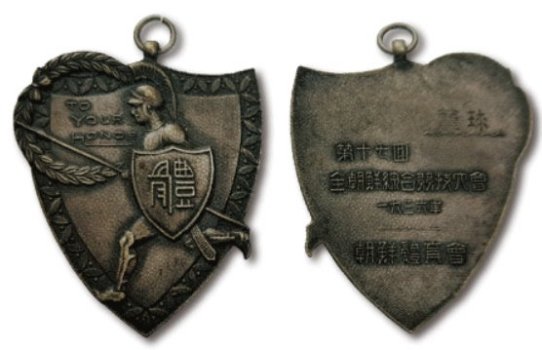
The Obverse has the inscription “To Your Honor” and with the Chinese character 體 “Body” on the face of the shield. The reverse inscription is “17th All-Korean General Athletic Competition” 第十七囬全朝鮮綜合競技大會 (in 2 lines), “1936” 一九三六年, and “Chosŏn Sports Association” 朝鮮體育協會. In the upper right is the inscription “Staff, Administration” 任員.

Identical to the other medal, but with two different reverse inscriptions: 籠球 “Basketball”, 陸上 and “Athletics”, respectively.
Information source: Korea History Museum
In the late 19th century, Christian Missionaries and other foreigners introduced the individual’s right to education. They also introduced soccer, basketball, volleyball, baseball, and tennis into the Korean peninsula. (Track and field (1896), gymnastics (1897), ice sports (the 1890s), shooting (1904) and tennis (1884)). Football (soccer) was introduced in 1882 by British sailors. U.S. marines, stationed in Seoul, taught Korean boys, the finer points of baseball and American football.1 In 1895 Emperor Kojong issued Imperial Order #49 and established the Legal Training School as the first modern higher education institution in Korea. The following year, saw the first modern Olympics being held in Athens, Greece, but it also saw the First School Sports Day in Korea. The promulgation of the Education Ordinance in 1895 had physical education as a major school program. In 1895, the Government Hanseong (Seoul) Foreign Language School 관립한성외국어학교 (官立漢城外國語學校) was established as the first public school. The school emphasized physical education in modern Korean sports, and hosted the first modern athletic meet ever held in Korea. Shortly after opening, gymnastics became a subject in its curriculum.
After the March 1st Movement in 1919, the necessity of organizing an athletic group emerged as one more form of Korea’s determination for independence. In that same year, the “Chosŏn Sports Association” (Japanese) was formed. On April 1, 1920, the newspaper Dong-A Ilbo published an editorial by Byeon Bong-Hyeon (邊鳳現) entitled “Discussing the Need for a Sports Institution”. Koreans responded by establishing their own “Chosŏn Sports Association”. It was felt that an association established for “Koreans Only” was justified. However, the founders of the Chosŏn Sports Association were not activists seeking independence, but, like many of the intellectuals, elites, and social leaders of the time, a fair number of them were pro-Japanese. Even so, many Koreans felt that the formation of a Korean organized sports group was another means of protest against Japanese colonialism.
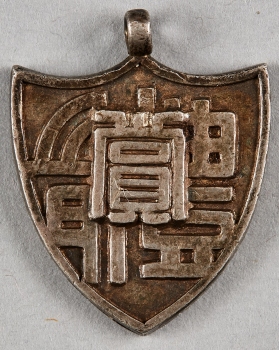
Commemorative medal for winning the 3rd All Chosŏn Athletics Championships hosted by the Chosŏn Sports Association on June 23-26, 1928. The medal is in the shape of a shield with a loop attached to the top. The Obverse has the words: “Award” 賞, superimposed over the word “Body” 體. The Reverse has “Three” 第三囬, “All-Korean Athletics”全朝鮮陸上競技, “Win” 優勝, “Commemorative” 記念, and “1928”
Information source: Korea EMuseum, Identification #구입 11502
On June 16, 1920, a promoters’ meeting was held for founding the ‘Chosŏn Sports Association’ (Korean). It was held at Myeongwolgwan 명월관 (House of Moonlight), a restaurant in Seoul, and had 47 people in attendance.2 On the 26th of June, the purpose for the founding and the general rules of the association were enacted. Less than a month later, on July 13th, 70 people gathered at the Central Church in Insa-dong to hold the inaugural general meeting.3 At the inaugural meeting, Lee Seung-woo, a promoter and lawyer, read the proposed association bylaws, which subsequently received unanimous approval. The Chosŏn Sports Association (Korean) existed without the support of the Japanese Government-General of Korea and consequently, was constantly plagued by a lack of funds. It existed on income from game tickets and donations. The 1st All-Chosŏn Baseball Tournament in 1920 was the first sporting event to introduce paid admission to the Korean Peninsula.). The Chosŏn Sports Association played a pivotal role in Korean Sports for 18 years until it was forcibly disbanded.
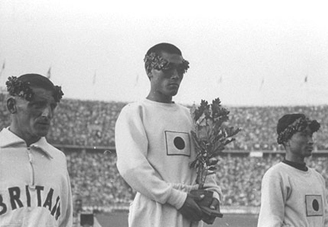
Ran in the marathon race in the 1935 All-Chosŏn Games. He would later win the Gold Medal at the 1936 Summer Olympics in Berlin, Germany.
For more information about this remarkable Korean patriot, see https://en.wikipedia.org/wiki/Sohn_Kee-chung.
Various “1st Competitions” were held under the auspices of the (Korean) Chosŏn Sports Association, such as the 1st All-Chosŏn Soccer Tournament in 1921, the 1st All-Chosŏn Tennis Tournament also in 1921, the 1st Athletics Championship in June 1924, and the 1st Ice Skating Championship in 1925. The 1929 National Athletic Tournament was held under the auspices of the (Korean) Chosŏn Sports Association as a comprehensive competition. It was held from June 13 to October 26, 1929, in Gyeongseong. During this athletic tournament, the 1st All-Chosŏn Ssireum (Korean Style Wrestling) Tournament, the 10th All-Chosŏn Baseball Tournament, the 6th All-Chosŏn Athletics Championships, the 9th All-Chosŏn Tennis Tournament, and the 10th All-Chosŏn Soccer Tournament were held. Before 1934, each All Chosŏn sporting event (i.e., baseball, soccer, tennis, etc.) was generally held at different times of the year in Seoul. That changed in 1934 when all the various sports competitions were integrated into a single annual event. The event was located at different venues in Seoul and included baseball, football, tennis, track and field, and basketball. In 1935, judo, wrestling, kendo, and weightlifting were added, followed by ice skating, boxing, and table tennis in 1936, and volleyball in 1937. The All-Chosŏn Athletic Competition of 1934 was held to commemorate the 15th anniversary of the founding of the (Korean) Chosŏn Sports Council. This event is felt to be the origin of the today’s Korean National Athletic Tournament. However, the modern athletic events are numbered as is they had started in 1920, with the 100th National Athletic Festival being held in 2020.
In February 1942, the Japanese Governor-General of Korea created the Chosŏn Sports Promotion Association and in June 1942, the Chosŏn School Sports Promotion Association. On July 4, 1938, the (Korean) Chosŏn Sports Association was forcibly integrated into the (Japanese) Chosŏn Sports Association, the same Japanese sports organization that was originally founded in 1919. After this, all sports were tightly controlled by the Japanese government until liberation. It is not surprising that physical education in Chosŏn was used as a means of war preparedness. Physical fitness tests were conducted on young people aged 18 to 19, ball games at universities and vocational schools were abolished. Because of the Japanese need for sailors, swimming became a “National Defense Game”. The 18th All-Chosŏn Games (1937) were suspended indefinitely.
National Sports Tournaments
Several sports tournaments were hosted by the Korea Sports Association 조선체육회. The tournaments were held in various facilities located in Gyeongseong-bu (Seoul). The first Tournament held in 1920 was not a comprehensive sporting event, but a baseball conference and was officially called the “All Chosŏn Baseball Tournament” 전조선야구대회 (全朝鲜棒球大会). It was held at Seoul’s Baejae High School (배재학당) Stadium4 In the following year, soccer, and tennis were added, and the name was changed to “National Sports Tournaments” 전국체육대회 (全國體育大會). Additional sporting events were added and by 1925, the tournament became a far more comprehensive sports competition. 1925 was also the year with a tournament devoted to Winter Sports. In 1929, to reflect the inclusion of additional sports, the name of the tournament was changed to the “All Chosŏn Tournament” 전 조선경기대회 (全朝鮮競技大會). (The 1929 competition was widely advertised as the first Korean “Olympics.”) The 15th General Assembly, held in 1934, commemorated the 15th anniversary of the founding of the Chosŏn Sports Association. At this time, the name of the tournament was changed again to “All Korea Comprehensive Sports Tournament” 전조선종합경기대회 (全朝鮮綜合競技大會). The Chosŏn Sports Association also sponsored a National Boys Sports Tournament 전국소년체육대회, which targeted elementary and middle school students. These tournaments were held separately. South Korea’s National Youth Sports Tournament is an annual event which started in 1972 and does not trace back to the original National Boys Sports Tournament. Here is a list of the National Sports Tournaments that I have been able to put together:
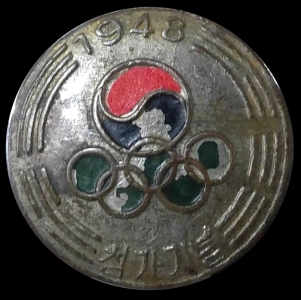
for the 1948 London Olympics
Manufactured in Korea
Picture Source: 1948 년 런던올림픽 참가 기념 배지
- 1920 National Sports Tournament was held from November 4 to 6, 1920.
- 1921 National Sports Tournament was held from February 11 to October 3, 1921.
- 1922 National Sports Tournament was held from February 11 to November 25, 1922.
- 1923 National Sports Tournament was held from May 17 to December 8, 1923.
- 1924 National Sports Tournament was held from May 16 to November 1, 1924.
- 1925 National Winter Sports Tournament was held on January 5, 1925.
- 1925 National Sports Tournament was held from April 28 to October 17, 1925.
- 1926 National Sports Tournament was held from June 17 to November 20, 1926.
- 1927 National Sports Tournament was held from June 3 to November 4, 1927.
- 1928 National Sports Tournament was held from May 18 to November 5, 1928.
- 1929 All Chosŏn Winter Sports Tournament was held on January 20, 1929.
- 1929 All Chosŏn Tournament was held from June 13 to October 26, 1929.
- 1930 All Chosŏn Winter Sports Tournament was held on January 25, 1930.
- 1930 All Chosŏn Tournament was held from June 12 to November 8, 1930.
- 1931 All Chosŏn Winter Sports Tournament was held on January 25, 1931.
- 1932 All Chosŏn Tournament was held from May 27 to Dec. 10, 1932
- 1933 All Chosŏn Tournament was held from May 18 to Dec. 2, 1933
- 1933 All Chosŏn Winter Sports Tournament was held on January 22, 1933
- 1934 All Chosŏn Comprehensive Athletic Tournament was held from Nov. 2 to Nov. 5.
- 1935 All Chosŏn Comprehensive Athletic Tournament was held from Oct. 11 to October 26.
- 1936 All Chosŏn Comprehensive Athletic Tournament was held from Sept. 6 to October.
- 1937 All Chosŏn Comprehensive Athletic Tournament was held from Sept. 8 to October.
- 1939 games were usurped by the Japanese and are not counted as legitimate.
A word of caution, Koreans do not refer to the Chosŏn Shrine Games as an athletic event of the Korean people because it was prepared and operated by the (Japanese) Chosŏn Athletic Association, was funded in part by the Chosen Government General, and because most competitors were Japanese, who got preferential treatment. There are very few Korean websites that discuss the Shrine Games.
In 1937, the Japanese colonial authorities created the Chosŏn Student Sports Federation 조선학생체육총연맹 (朝鮮學生體育總聯盟) which was designed to control the sports organizations of all colleges and universities on the peninsula. It ceased to exist in 1941 as the war inexorable turned against Japan. On July 4, 1938, to control all facets of Korean society and to redirect the country towards total war, the Chosŏn Sports Association was forced to shut down. All of its activities and assets were now under the umbrella of Japanese colonial rule. In 1942, the Chosŏn Sports Promotion Association 조선체육진흥회(朝鮮體育振興會) was established to lead to the imperialization of the sports field. In other words, to make it useful for the war effort.
Two days after Korea’s liberation, sports enthusiasts held a meeting in Seoul and agreed to resurrect the original Chosŏn Sports Association, which came to fruition on Sept. 5, 1945. October 27 to 31, 1945, saw a new national sports tournament in Seoul under the name of the “Liberation Celebration National Sports Tournament” 해방경축 전국종합경기대회, but often referred to as the “Chosŏn Olympic Games” 조선올림픽대회. This was the last time that North Korean athletes participated in a pan-national sporting event. Syngman Rhee (the future president of the Republic of Korea), Sohn Kee-chung 손기정, 孫基禎 (the 1936 Olympic gold medalist in the marathon) and Kim Eun-bae 김은배 (who finished sixth in the marathon at the 1932 Los Angeles Olympics) were in attendance. Korean women and members of the U.S. Military Army Government in Korea (USAMGIK) also competed. The 1945, 26th games actually did not finish until the close of the winter portion of the games in January of the following year. In 1946, approx. 5,000 athletes competed in 13 events under the name of ‘Chosŏn Olympic Games’ 조선올림픽대회. With the creation of the Republic of Korea in 1948, the Chosŏn Sports Association 조선체육회 officially changed its name to the Korean Sports Association 대한체육회. The annual tournament was also renamed as the ‘National Sports Tournament’ 전국체육대회. Modern National Sports Tournaments are numbered from the first such event in 1920, so the 1948 tournament was the 29th competition. No games were held in 1950 due to the outbreak of the Korean War, but the games did resume in 1951. In 1953, Zainichi (Koreans living outside of Korea) were allowed to participate. The 36th National Sports Tournament (Oct. 1955) saw the first torch relay. Although only symbolic, place markers are used during the opening ceremony of the competitions to indicate the inclusion of North Korean athletes. In the first 100 years of the competition, there were only 11 years when the competition did not take place.
The Chosŏn Shrine 조선신궁 (朝鮮神宮)
The earliest Shinto shrine in Korea is believed to be Kotohira shrine (金刀比羅神社), later Ryūtōsan Shrine (龍頭山神社), built in 1678. After the annexation of Korea in 1910, the Japanese government embarked upon a policy of assimilation, which included worshiping at Shintō shrines. As early as 1911, the existing state rituals performed by the Chosen Dynasty were deprived of public status because of their similarity to Japanese Shintoism. Shinto rituals at Keijo Jinja 京城神社 (경성신사) replaced the public viewing of Korean Dynasty rituals. Keijo Jinja was a local (resident sponsored) shrine located on Namsan (남산, 南山, South Mountain). The Namsan location has been a heavily forested, sacred mountain for the protection of the Korean royal family since ancient times. It was forbidden to cut down the trees. In 1913, members of the Korean royal family presented offerings to Amaterasu at Keijō Jinja, signaling their subordination to the Japanese government. After completing several years of basic research and preparation, the Japanese Government-General submitted the ‘Proposal for the Establishment of Chosŏn Shrine’ 조선신사 창립에 관한 청의(請議) to the Japanese Cabinet on December 16, 1918, and established the Chosŏn Shrine in accordance with Japanese Cabinet Notice No. 12 dated July 18, 1919. The establishment was confirmed and announced.On July 18, 1919 (Taisho 8), it was ordered that a “Chosŏn Jinja” 朝鮮神社 be established, with Amaterasu Omikami (Goddess of the sun and the universe; the mythical ancestress of the Imperial House of Japan) and Emperor Meiji as its deities, and that it be ranked as a government-sponsored shrine. A ground-breaking ceremony (地鎭祭) was held on May 27, 1920. It was the first Korean Shinto shrine to be funded by the state.

Reverse at top: Worship Hall 奉賛殿 (봉찬전) ,
and at the bottom: Raising the Ridgepole 上棟 (상동)
Date of manufacture: 1925
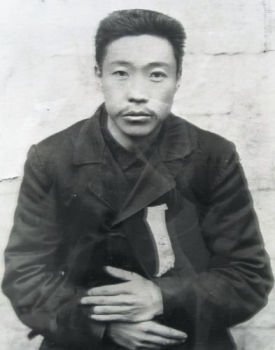
Picture taken after his arrest. Notice that he is missing the last joint of the ring finger. He cut it off in 1909 as a pledge to kill Itō Hirobumi. His intentional positioning of his left hand was clearly an act of defiance.
Terrorist/Patriot, two sides of the same coin.
On June 27, 1925 (Taisho 14), “Chosŏn Jinja 朝鮮神社” was renamed “Chosŏn Jingu 朝鮮神宮”.5 The renowned Japanese architect, architectural historian, and critic, Itō Chūta (伊東 忠太, 1867 – 1954) contributed to the planning of the new Worship Hall. This should not be confused with Meiji Jingu 競技大会, which is located in Tokyo, Japan. On Sept. 15, 1925, an enshrinement ceremony took place. On October 15, 1925 (Taisho 14), Deputy Chief of Staff, Saneyasu Sonoike園 池実康, of the Imperial Household Ministry Ceremony Department 宮内省式部職掌 attended as an imperial envoy to a solemn ceremony 鎭座祭 to enshrine the spirits of the deceased. Two days later, the first of what was to be an annual festival was held, with the imperial envoy in attendance. Thereafter, an imperial envoy attended every annual festival, and the chief priest of the main shrine was treated as an imperial appointee. Moreover, beginning in 1925, school pupils were legally required to attend Shinto shrines. In October 1925, a commemorative athletics festival named after the shrine, the “Chosŏn Jingu Athletic Meet” (朝鮮神宮競技大)” was held at the recently completed Keijo Athletic Grounds, featuring baseball, tennis, track and field events. This multi-sports tournament was held yearly until October 17, 1941.
About 1935, Keijo Jinja was elevated to a national shrine, and it became compulsory for university students and government employees to attend Shinto ceremonies. This was part of the imperialization policy 皇民化政策の一環 to turn the Koreans into imperial subjects (acculturation). This compulsory participation caused a significant disagreement within the Christian community in Korea. Under the National Mobilization law 国家総動員法 of March 24, 1938, all Christian schools were required to visit shrines. In September 1938, members of a Presbyterian church in Korea were forced to visit a shrine by soldiers with fixed bayonets. To keep Christian schools open, many Christians became increasingly tolerant of shrine worship.6 If a person did not show enough reverence at the shrine, they and their entire family could be arrested. To complicate the matter, a third national shrine called Keijo Gokoku Jinja 京城護國神社 (Nation-Protecting Shrine) was built on Namsan about 1943. This shrine was constructed to honor the spirits of the fallen heroes who sacrificed themselves for Japan. By 1945, there were a total of 1,140 Shinto shrines in Korea. (Sources vary, but it is safe to say there were at least 1,000.)
There was an argument that Korea’s foundation myths be incorporated into the Shinto Shrines; however, the State apparatus declined to incorporate Tan’gun 檀君王儉 (단군왕검) or Yi Sŏng-gye 李成桂 (이성경), the founder of the Chosŏn Dynasty. It was believed by the Japanese in Korea, that as soon as Japan lost the war, the Shinto Shrines in Korea would become a focus of contempt, and targets for “revenge” by the Korean people. Signs were posted on walls urging Koreans to burn them down, and many of them actually were burned down or at least pilfered. On Aug. 16, 1945, the day after the Emperor announced his acceptance of the Potsdam Declaration, the “Rite of Ascending the Spirit” (神霊昇神儀) was held at Chosŏn Jingu 朝鮮神宮. After this, even if the Koreans were to destroy the complex, it was no longer a shrine. The sacred objects were sent back to Japan from Yeouido Airfield 汝矣島空港 (여의도공항) on August 24th. On September 7th, the construction company Matsuyama Kichishiro 業松山吉四郎 was ordered to start the demolition and incineration of the former shrine. However, the American forces that entered Seoul immediately afterward ordered the work to be halted. All Shinto Shrines in Korea had been placed under the control of the US Military Government in Korea (USAMGIK) as “Enemy Property”. Those involved with the shrine on Namsan and the Government-General of Korea pleaded with the American military authorities, saying they could not let Koreans destroy the buildings; after which they were given permission to resume the demolition. The majority of the work was completed on October 6th with the remaining structures being incinerated the following day. The shrine was permanently closed on November 17, 1945. Christian groups, having resisted the forced worship of shrines, planned to build a Christian museum and a non-denominational chapel on the former site of the Chosŏn Shrine, but their plans failed to materialize. On June 6, 1947, following the transfer from the US Military Government, of “enemy property” to the Seoul Metropolitan Government, several million won was set aside to demolish 57 torii gates 鳥居and Imperial Subjects’ Oath Towers in the city starting on June 30.
In 1955, to commemorate the then-President Syngman Rhee’s 80th birthday, it was decided to erect a statue of Syngman Rhee at the site of Chosŏn Shrine. The statue was about 24 m tall (including the base), however, due to the April 19 Revolution in 1960, protesters pulled down the statue and destroyed it.
On October 26, 1932, the Japanese unveiled the Hakubun-ji 博文寺 Buddhist Temple dedicated to Itō Hirobumi (伊藤 博文 1841 – 1909), the first Japanese Resident-General of Korea. It was situated on the north slope of Namsan. 7 In 1970, the “Patriot An Chung-gun Memorial Hall” 안중근의사기념관 was constructed on the site of the former Japanese shrines. It honors the patriotism of An Chung-gun (안중근, 安重根) who assassinated Itō Hirobumi.8
Chosŏn Shrine Sporting Events
Construction on what was to be the main athletics stadium and baseball field in Seoul, Korea began on May 24, 1925, and was completed on Oct. 5, 1925. It was built to commemorate the emperor’s marriage, and opened for use on October 15th as Gyeongseong Stadium 경성운동장. The official opening ceremony was 10 days of Meiji Shrine games. The Koreans, to draw attention away from the opening games, scheduled the All Chosŏn Baseball Tournament at the Baejae High School Stadium on the same date. The following year, a soccer field and tennis courts were added, and the spectator seats were refurbished.
During the Japanese colonial period, numerous events were held such as the Chosŏn Shrine Games, the All Chosŏn Tournament, and even the funeral for Emperor Sunjong. Soon after its completion in 1925, the 1st Chosŏn Shrine Games 朝鮮神宮競技大會 were held under the auspices of the Governor-General of Korea, and organized by the (Japanese) Chosŏn Sports Association. These games are sometimes translated as the Chosŏn New Palace Games, which is not correct. The event was held a total of 18 times until 1942. The Chosŏn Shrine Games also served as a selection match to select athletes from Korea to participate in the Meiji Shrine Games, which opened in 1924 at the Meiji Shrine Stadium in Tokyo. Korean athletes were not allowed to participate in the Tokyo Meiji Shrine Games until the 7th tournament in 1933. Unlike the Chosŏn Shrine Games, where Korean athletes compete for supremacy, the Meiji Shrine Games attracted a lot of attention from Koreans because it was a confrontation between Korean and Japanese athletes. The games were abolished in 1943 when the Japanese government completely halted all cultural activities, including sporting events. Because of this, Koreans did not compete in the last Tokyo Meiji Shrine Games in 1943.
The Gyeongseong Stadium was the location for mass celebrations of the end of Japanese colonial rule, as almost 250,000 citizens gathered on August 15, 1945, to celebrate the liberation of their peninsula. Also in 1945, after Japan’s surrender, the name was changed to Seoul Stadium 서울운동장. It was located near Dongdaemun (Great East Gate) in Seoul, so in 1985, the venue name was changed again, to Dongdaemun Stadium 東大門運動場 동대문운동장. The stadium was demolished in 2008, but some remnants are being preserved and there is a small historical museum on the site.
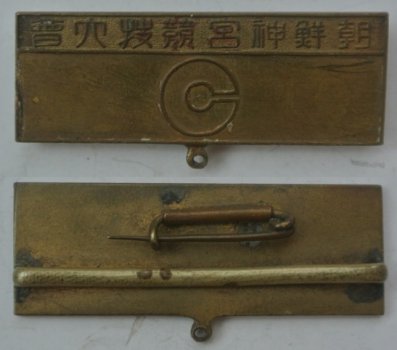
Information source: https://blog.naver.com/ruler01/220102257461
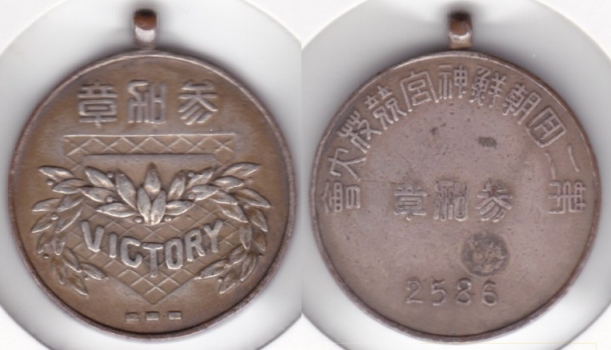
The Obverse Inscription is: 參加章 “Participation Medal” followed by the word “Victory”
The Reverse Inscription is: 弟二囬朝鮮神宮競技大會 “2nd Chosŏn Shrine Athletic Contest”, followed by 參加章 (참가장) “Participation Medal” and at the bottom 2586 (1926)
Information source: Naver Blog Post
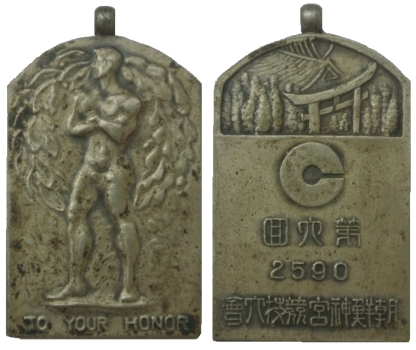
弟六囬 2590 朝鮮神宮競技大會
Image source: https://blog.naver.com/ruler01/220095559173
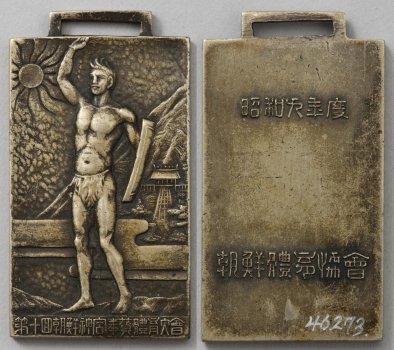
The obverse inscription is 弟十囬朝鮮神宮奉贊體育大會 “10th Sport Tournament of Chosŏn Shrine supporting (Association or Offering Association, i.e., an organization that supports a temple or shrine) Contest”. The reverse inscription at the top is 昭和六年度 “Showa 6th Year” (1931) and at the bottom: 朝鮮体育協會 “Chosŏn Sports Association”. The size is 4.3 × 2.4 cm.
Information source: National Folk Museum of Korea.
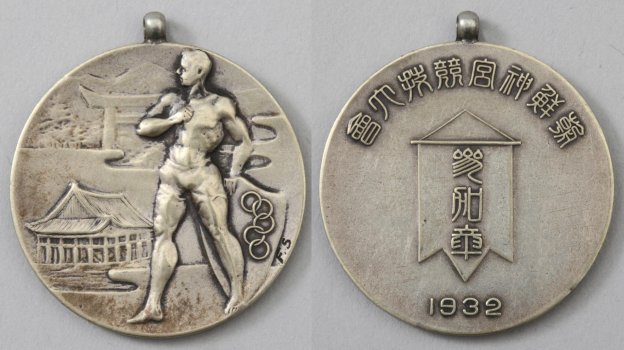
On the obverse of the medal are the initials ‘F.S’ but it is unknown who or what they represent. The reverse top rocker inscription is 朝鮮神宮競技大會 (조선신궁경기대회) “Chosŏn Shrine Athletic Contest”. On the pennant the inscription is 參加章 (참가장) “Participation Medal” and below this is the date 1932. It has a diameter of 3.8 cm.
Information source: National Folk Museum of Korea.

The large center inscription is 優勝 (우승) “Victory”, while the smaller left inscription is 朝鮮神宮奉贊体育大年 (조선신궁봉찬분육대년) “Chosŏn Shrine Supporting (Association or Offering Association, i.e., an organization that supports a temple or shrine) Sports Year”. Next to which is another shorter inscription 弟十四囬 (제십사회) “Fourteenth Time” (1935).
The size is 4.4 × 2.5 cm.
Information source: National Folk Museum of Korea.
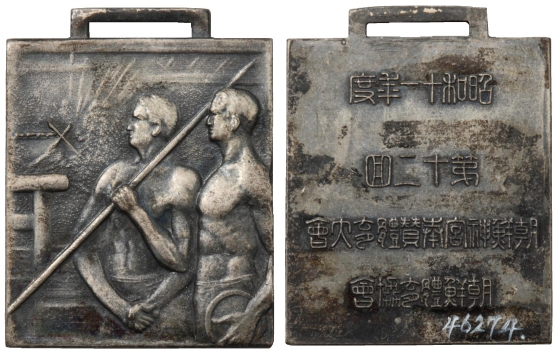
The reverse inscription is in 4 lines: 昭和十一年度 “Showa eleventh year” (1936), 弟十二囬 “the twelfth” (Games), 朝鮮神宮奉贊體育大 “Chosŏn Shrine Supporting (Association or Offering Association, i.e., an organization that supports a temple or shrine) Sports Center”, and 朝鮮體育協會 “Chosŏn Sports Association”.
Information source: National Folk Museum of Korea.

Obverse: a draped, seated semi-nude man holding a shield and, in the distance, can be seen Namdaemun (the Great South Gate in Seoul) and a Shinto torii gate.
Reverse: 13th Annual第十三囬 Chosen Shinto Shrine Athletic Meet 朝鮮神宮体定大會 and across the center 2597 弍五九七 (1937)
Bronze 33 mm
Part of the George Notarpole Collection
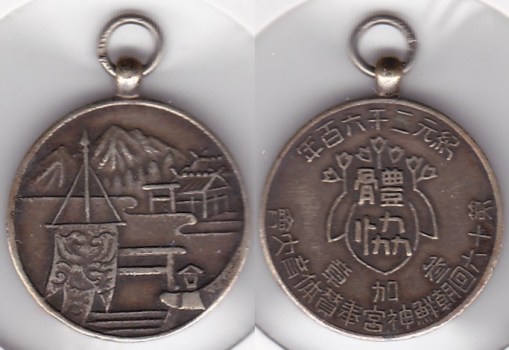
The reverse inscription: 紀元 二千六百年 “Era 2600 Years” (1940), 體恊 “Sports Association”, 參加章 “Participation Medal”, 第十六回朝鮮神宮奉贊体育大會 “The 16th Chosŏn Shrine Supporting (Association or Offering Association, i.e., an organization that supports a temple or shrine) Athletic Contest”.
Information Source: Naver Blog Post.
A few quick words on the YMCA
The turbulent history of Korea is reflected in the names used for the Young Men’s Christian Association (YMCA) located in Seoul. During the Korean Empire Period, it was ‘Hwangseong Christian Youth Association’ 황성기독교청년회. Hwangseong being an old name for the city of Seoul. After Korea was annexed by Japan, it was briefly changed to ‘Gyeongseong Christian Youth Association’ 경성기독교청년회. Gyeongseong (경성; 京城) is the Korean pronunciation of Keijo (けいじょう) which was the name given to Seoul by the Japanese. It was quickly changed to the ‘Central Christian Youth Association’ 중앙기독교청년회, meaning that it was located in the center of Seoul, and it is often called the “Central Agency, Seoul YMCA” 중앙기청, 서울 YMCA.9
In 1899, Koreans made a request with the World Alliance of YMCAs to establish a facility in Korea. After finishing research and surveys to launch a YMCA Movement in Korea, the Hwangsung (Seoul) YMCA was established on October 28, 1903, as the first YMCA in Korea. The first chairman was J. S. Gale, and the president (general secretary) was Phillip. L. Gillette. The YMCA played a crucial role in the introduction of Western sports into Korea. Seoul YMCA organized a baseball team, a soccer team, and a basketball team to play games with domestic schools and Japanese athletic groups. On October 28, 1912, the Seoul YMCA held its first baseball game in Japan, and in 1924, it also held a baseball game in Hawaii. In addition, the YMCA basketball team went to Japan five times in 1920, 1923, 1927, 1929, and 1932. They asked Waseda University in Japan and other Japanese basketball teams to play in Korea. In addition, the Seoul YMCA built an indoor gymnasium and established the Basketball Federation, which is played as a night game, contributing to establishing basketball as an indoor winter sport. A Chosŏn Football Championship was held at the Pyongyang YMCA. Between 1909-1911, the Seoul YMCA baseball team had several tours of the peninsula, and played ball in both Pyongyang and Kaesong.
In 1916, the YMCA built an indoor gymnasium, called Christian Hall 기독회관. It was a multipurpose wooden structure (Approx. 165 m × 122 m) in which indoor games such as basketball were played.10 It was here that Koreans first played night games in a loose Basketball Federation with other groups. These night games established basketball as an indoor winter sport. This is believed to be the true beginning of Korean basketball.
A few quick words about the Gwanseo Sports Association 관서체육회 (關西體育會)
On April 19, 1922, the Pyongyang Christian Youth Association 평양기독청년회 was launched at the Pyongyang Christian Youth Center 평양기독청년회, but it did not show significant activity after its launch. Accordingly, on February 27, 1925, sports enthusiasts in Pyongyang held a meeting to launch the Pyongyang Sports Association 평양체육회 also known as the Gwanseo Sports Association 관서체육회 (關西體育會). Gwanseo is a cultural region located in North Pyeongan Province 평안북도 (平安北道) and South Pyeongan Province 평안남도 (平安南道) where Pyongyang is located. At that time, sports organizations were organized in each major region of the country, but this organization was in direct competition with the (Korean) Chosŏn Sports Association 조선체육회 (朝鮮體育會). The Chosŏn Sports Association was founded on July 13, 1920, as an organization representing and unifying the whole of Chosŏn. The Gwanseo Sports Association made significant contributions to the development of sports in Chōsen during the Japanese colonial period. Among the projects promoted by them were various competitions such as soccer, tennis, swimming, volleyball, and basketball.
Aquatics

Information Source: EMuseum, Identification #구입 11482
A silver medal designed to be awarded to the winners of the 5th All Korea Aquatics Championship 全朝鮮水上競技大會 which was held in September 1934, hosted by the Chosŏn Sports Association and sponsored by the Dong-A Ilbo newspaper. On the obverse of the medal, there are three divers poised at the starting line with the phrase ‘Victory’ above them. The reverse contains the words “Award” 賞, “5th All-Korea Aquatics Competition” 第五囬 全朝鮮水上競技大會, “Sept. 8-9,1934” 一九三四.九.八-九., “Hosted by Chosŏn Sports Association” 主催 朝鮮體育會, “Support Dong-A Ilbo” 後援 東亞日報社. It is in a lined fitted box. On the underside of the box lid, there is a label for the Sanyuan Insignia Factory (三元徽章工場).

Picture source: World Militaria Forum.
Baseball
There are claims that baseball was introduced into Korea in 1905 by Phillip Gillett, an American missionary at the Hwangseong YMCA in Seoul. The YMCA did sponsor the first official Korean baseball match on Feb. 11, 1906, but it was not the first introduction of baseball into Korea. Ten years earlier, the American legation guard challenged the American residents of Seoul to a friendly baseball match, which took place on April 25, 1896, in a small field outside the West Gate. 11 While the audience was primarily the foreign community in Korea, many Koreans were also in attendance. In the diary of Fujiyama Fujisawa 후지야마 후지사와의, a Japanese student at the Incheon English Night Society 영어야학회 (now Yeonghwa Elementary School 영화초교), there is an entry of him playing a ball game called ‘baseball’ in 1899. In 1922, when baseball was just beginning to become popular, 13 teams participated in a youth baseball tournament in the Inchon area. The Chosŏn Baseball Association 조선 야구협회 was found in 1923, but was disbanded by the Japanese in 1938. Baseball fast became a popular game for children, especially among boys. A children’s game called Gwongu 拳球 (권구 Boxing Ball or Fist Ball) originated in Incheon and Seoul as a simple game to imitate baseball. Since baseball equipment was expensive, children played with their fists using a soft ball such as a sponge ball that existed at that time. Gwongu, also known as jjimpu, was played even after liberation, but gradually disappeared in the 1980s, when Korean society was finally able to escape from poverty.12
The YMCA introduced basketball, volleyball, and swimming to Korea, and although historically, it did not introduce baseball, it did popularize the sport in Korea.
Regarding the Baseball Fob pictured at right. Although it is not dated, it is pre-World War II. The inscriptions for pre-war fobs are generally done in Seal Script. This fob is done in Traditional Chinese Characters. This is not typical for the times, but the fob is for a middle school, and the students would not be familiar with Chinese Seal Script. (Middle School was, at the time, typically grades 7, 8, & 9. It is generally referred to as Junior High School in the U.S.) I have been unable to find any references to the Dainichi (Daeil 대일중학교) school.
Basketball
In 1903, the Hwangseong Christian Youth Association (YMCA) 황성기독청년회 (YMCA) was founded. It is believed that Phillip L. Gillette질레트 imported basketball to Korea on or before 1907. In 1914, numbered player uniforms became mandatory. The 1st Chosŏn Basketball Tournament 조선농구대회 was scheduled in 1918.
The Seoul YMCA organized a basketball team to play games with domestic schools and Japanese athletic groups. The YMCA basketball team went to Japan five times (1920, 1923, 1927, 1929, and 1932). They also invited Japan’s Waseda University and other Japanese basketball teams to play in Korea.
A Chosŏn Basketball Association 조선바스켓볼협회 was created on September 18, 1925, but was soon disbanded due to conflicts with the activities of the Christian Youth Sports Club 기독청년운동부. It is unclear, if the Christian Youth Sports Club is referring to the YMCA or to the Gwanseo Sports Association 관서체육회 (關西體育會) founded under the auspices of the Pyongyang Christian Youth Association 평양기독청년회.
October 4, 1925, saw the 1st all Chosŏn Volleyball/Basketball Tournament 전조선 배구 농구대회가 바로. It was hosted by the Japanese-run All Chosŏn Newspaper 전조선 신문사.
In the winter of 1930, the Songsil Technical School 숭실전문학교 and the Pyongyang branch of the Donga Ilbo newspaper sponsored the first All-Pyongyang Basketball League Competition.
1931 was a busy year for Korean Basketball. April 11th saw the establishment of a new Chosŏn Basketball Association 조선농구협회. (The previous association used the word 바스켓볼 in its title. This is a phonetic transliteration of the word “Basketball”. The new association used the modern term 농구 (籠球), which technically means “Cage Ball”. In China, they use a slightly different term for basketball, namely: 籃子 (람자).) On April 21st, the Chosŏn Basketball Referee Association 조선농구심판협회 was created. May 9th saw a General Club Federation Match game with the 1st Middle School Team 제1회 중학단. It was at this match that the Chosŏn Basketball Association held its Founding Ceremony. On June 11th, the Chosŏn Basketball Team 조선농구단 was established. Although not directly affiliated with the Chosŏn Sports Association 조선 체육회 (朝鮮體育會), the original Chosŏn Basketball Association (1925), the successor Chosŏn Basketball Association (1931), and the Chosŏn Basketball Umpires Association (1931) were cooperative organizations. (Today, the Korean Sport & Olympic Committee (KSOC) traces its roots back to the Chosŏn Sports Association.)
In 1932, the first international basketball meeting was held in Geneva, Switzerland, and the International Amateur Basketball Association was established in Rome, Italy. Basketball was adopted as an official Olympic event on Oct. 10, 1934, with the first basketball games being played at the 11th Berlin Games in 1936.
The Chosŏn Sports Association held a general meeting on May 31, 1934, and in October, in commemoration of the 15th anniversary of the founding of the Chosŏn Sports Association, five events, including soccer, baseball, tennis, track and field, and basketball, were held as the 15th Chosŏn General Games. These were the only games held in Korea without an opening or closing ceremony, nor were any scores recorded.

Picture source: Korean EMuseum Identification #구입 11505
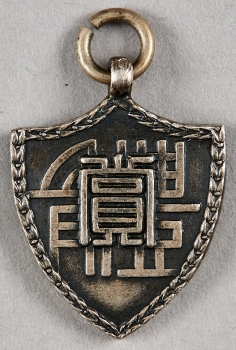
Picture source: Korean EMuseum, Identification #구입 11509
When the Sino-Japanese War broke out in 1937, the Japanese Government-General of Korea began integrating various sports organizations across the country. By 1938, virtually all sports were under the administration of a new Japanese controlled Chosŏn Sports Association.
After the liberation of Korea, a new Chosŏn Basketball Association 조선농구협회 발족 was created in November 1945. After the creation of the Republic of Korea, the name was changed to the Korea Basketball Association 대한농구협회. In 1947, Korea joined the International Federation of Basketball (FIBA) 국제 농구 연맹. Korea also joined the International Amateur Basketball Federation 국제아마추어농구연맹 on June 10, 1947.
A Korean basketball team competed at the 1948 Summer Olympics in London, England. While the Korean men’s team has never won an Olympic medal in basketball, the Women’s team won a silver medal at the 1984 Los Angeles Olympic Games 제23회 미국 LA 올림픽 대회.
The fob (at Left) was awarded to the winner of the middle school division in the 9th Basketball League match held in 1935 hosted by the Chosŏn Central Christian Youth Association. On the front, there is a pattern of five people surrounding a basketball with the letters ‘B.B.’ for Basketball. On the back, the inscriptions “First Time” 第囬, “Basketball Federation Team” 籠球聯盟軍, “Middle School”中學郶, “Excellence” 優, and “Hosted Chosŏn Central Christian Church Annual Conference” 主催朝鮮中央基督敎靑年會, “Ninth” 九 and “1935”.
The medal (at right) is for the winners in basketball at the 18th All Chosŏn General Games, hosted by the Chosŏn Sports Association 조선체육회 in 1937. The medal is in the shape of a shield with a loop attached to the top. The Obverse has the word “Award” 賞, superimposed over the word “Body” 體. On the reverse there are “XVIII”, “All Chosŏn General Athletics Championships” 全朝鮮綜合競技大會, “Win” 優勝, “Chosŏn Sports Association” 朝鮮體育會, and “1937”. At the center of the reverse is “Basketball” 籠球 and at the bottom is “Sterling silver” 純銀.
Boxing
Boxing became active on Oct. 7, 1912 when the Yugak Boxing Club 유각권투구락부(柔角拳鬪俱樂部) was founded by Park Seung-pil 박승필.13 In Dec. 1916, Mr. Philip L. Gillette (길예태 Gil Ye-tae), an American missionary working at the YMCA, introduced modern boxing gloves. On December 24, 1919, at the YMCA Gymnasium, Korea’s first open boxing match was held. In 1922, the YMCA introduced boxing as an indoor sporting event, which, thereafter, became an annual event. In September 1924, the YMCA officially established a boxing club and installed a ring. On January 30, 1925, at the 9th YMCA Sports Day, boxing was adopted as an official event with standards and facilities. In 1928, the 1st Chosŏn Boxing Championship제1회 전조선권투선수권대회 was held in Seoul, sponsored by the Dong-A Ilbo, and hosted by the Chosŏn Central Christian Youth Association. This continued until the 14th tournament in 1941. Boxing developed rapidly with the establishment of the Chosŏn Boxing Club 조선권투구락부 on Sept. 17, 1929 and the establishment of a dedicated gym two years later. Then, on January 20, 1932, the All Chosŏn Amateur Boxing Federation was formed. In 1933, the Chosŏn Sports Association (predecessor of the Korea Sports Association) held a meeting and declared the amateur rules for boxing, intending to distinguish between professionals and amateurs ahead of the 2nd National Championships. The Chosŏn Amateur Boxing federation 조선아마튜어복싱연맹 / 조선아마추어권투연맹 was created on January 20, 1934. In 1945, both the Korean Boxing Federation 대한권투연합회가 and the Chosŏn Boxing Federation 조선권투연맹이 were created. On Oct. 23, 1945, the Chosŏn Amateur Boxing Federation 조선아마튜어권투연맹 was founded. The Chosŏn Amateur Boxing Federation joined the International Amateur Boxing Federation 국제아마튜어복싱연맹 in 1947 and established the Asian Amateur Boxing Federation (FAABC) 아시아아마튜어복싱연맹 in 1962 for the development of boxing in Asia. In March 1947, these two organizations were merged into the Korea Boxing Federation 대한권투연맹으로, and then reorganized into the Korea Boxing Committee 한국권투위원회로 in the early 1960s, which oversees professional boxing until now. In 1947, the Chosŏn boxing federation joined the International Amateur Boxing Federation (AIBA), and in May 1953, it was registered as an official member of the Korean Sports Association. And on December 3, 1962, it became a founding member of the Asian Amateur Boxing Federation (FAAB). In February 1963, it was renamed the Korea Amateur Boxing Federation, which continues to the present day.
Korean boxers dominated the Japanese boxing world in the early 1930s and participated in Olympic competitions as Japanese athletes. The first professional Korean boxer was Kim Jeong-yeon 김정연 (金正淵). He played an active role in Japan under the name of Kobayashi Nobuo 고바야시 노부오. In June 1930, Kobayashi was the first boxer to die in Japan from injuries suffered in the ring. Hwang Eul-soo 황을수 (黃乙秀) won first place in the lightweight division in the Japanese national team selection event held before the 10th Los Angeles Olympics. He is the first Korean to make it to the Olympics, unfortunately he faced the “winning” gold medalist in the first round and lost by decision. Hwang Eul-soo was said to have a Stone Fist ‘핵주먹’ (also translated as Hearth Stone, but contemporary translation is ‘Nuclear Fist’). Lee Kyu-hwan 이규환 (李圭換) participated in the 1936 Berlin Olympic Games. Seo Jeong-kwon 서정권 (徐廷權), moved to the United States, where he became the first Korean to place in the world rankings, taking 6th place in the flyweight division. In 1948, Han Su-an 한수안 (韓水安) won the bronze medal for the first time at the 14th London Olympic Games. At the 23rd Los Angeles Olympic Games in 1984, Shin Jun-seop 신준섭 (申俊燮) won the first gold medal in the history of Korean boxing.

Photo source: Korean EMuseum, Identification #구입 11484
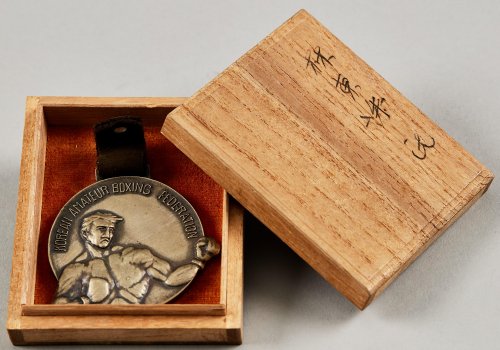
Photo source: Korean Emuseum, Identification #구입 11483
The silver fob (at left) was awarded to a participant at the 1st All Chosŏn Amateur Boxing Championships. On the obverse, there is a boxer wearing gloves and the inscription ‘KOREAN AMATEUR BOXING FEDERATION’. You can clearly see the leather strap that is attached to the top loop. On the reverse, it carries the inscriptions “1st All Chosŏn Amateur Boxing Championships” 第一囬全朝鮮 Amateur 拳鬪選手權大會, “All Chosŏn Amateur Boxing Federation” 主催全朝鮮 Amateur 拳鬪联盟, “Chosŏn Sports Association” 朝鮮體育會, “Sponsored by the Chosun Ilbo” 後援 朝鮮日報社 (Newspaper)14, and “1934”. The inscription on the lid of the box is “Mr. Lim Dongsu” 林東洙 氏 (림동수 씨) the recipient of this particular fob. Inside, the top cover is the label of the Sanyuan Insignia Factory 三元徽章工場 (삼원휘장공장). No dimensions are given by the Korean EMuseum
The silver fob (at right) was given to the participants of the Chosen Boxing Preliminary Tournament. The winners, then competed in Japan, and if successful were then sent to the 1936 Summer World Olympics in Berlin, Germany. The obverse of the silver fob has the figure of a boxer wearing gloves, the five Olympic rings and the phrase ‘K.A.B.F’ which stands for the Korean Amateur Boxing Federation. The reverse carries the inscriptions “World Olympics sends Chosŏn boxers to the preliminaries” (World Olympics 派遣朝鮮拳鬪豫選大會), “Hosted by All Chosŏn Amateur Boxing Federation” (主催 全朝鮮 amateur 拳鬪联盟), “Sponsored by The Chosŏn Ilbo” (後援 朝鮮日報社 Newspaper), and “1936”. Inside the box cover, there is a label for the Sanyuan Insignia Factory (三元徽章工場). Although you cannot see it, on the top of the cover, according to the Korean EMuseum, it has the word ‘合’ which means to combine. The medal is 5.1 cm wide, 4.8 cm long, and has a thickness of 0.4 cm.
All Korea Old-Boy Athletic Meet

I have been able to find any information on this medal. On the obverse it has, “Victory”, “All Korea Old-Boy Athletic Meet” and “1937”. According to the information source, the reverse has “Korea Athletic Association” and another Taeguk symbol. Information source: Korea EMuseum, Identification #구입 11508
An interesting little side story about two members of the Japanese team at the 1936 Olympics
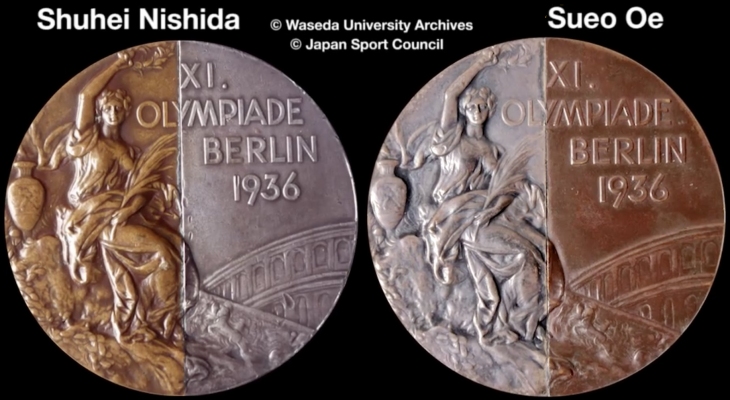
This story involves two Japanese Pole Vaulters, Shuhei Nishida西田 修平 (1910 – 1997) and Sueo Ōe 大江 季雄 (1914 – 1941). They were friends who competed against each other at the Berlin Olympic Games of 1936. Pole vaulters in those days landed on their feet in a pile of sawdust, and at that time there were no fixed number of attempts. At the 1936 Games, Earle Meadows of the United States won gold with a jump of 4.35 m. The two Japanese teammates were tied for second place with a height of 4.25 meters. Nishida and Ōe competed for more than five hours trying to break the tie. The judges ended the competition at 9:00 p.m. and left it up to the Japanese delegation to determine who among them should get the silver. The two athletes asked if their medals could be shared, but the Olympic officials refused, citing rules that only one person can win silver and the other had to take bronze. The delegation decided that Shuei Nishida would take the silver medal, as he took fewer attempts to reach 4.25 meters. Both of the participants were dissatisfied but accepted the decision. When they arrived back in Japan, Nishida and Ōe went to a local jeweler. They had their two Olympic medals cut in half, and fused into two new medals with equal bronze and silver halves. The Japanese press began calling these newly created medals, the ‘Medals of Friendship’.
There is a movie clip made by Leni Riefenstahl which provides a dramatic glimpse to the competition between the three men.
In 1937, Ōe set a national record at 4 m 35 cm that stood for 21 years. In 1939, he joined the Imperial Japanese Army and was killed in action in Luzon on December 24, 1941.
Four years earlier, Shuhei Nishida had won the Silver Medal at the 1932 Olympic Games in Los Angeles. At 41 years of age, he won a bronze medal at the 1951 Asian Games in New Delhi, India. He remained active in sports for the remainder of his life, serving as a referee in international competitions, as the appointed president of the Japanese Athletics Federation in 1959, eventually becoming an Honorary Vice-President and a member of the Japanese Olympic Committee. In 1989, he was awarded the silver medal of the Olympic Order. Nishida died of heart failure in 1997 at the age of 87.
More to come
Footnotes:
- Henry Appenzeller – A Modern Pioneer in Korea, by William Elliot Griffis, Fleming H. Revell Company, 1912, p.130.
- Myeongwolgwan restaurant opened on September 17, 1903. It served Hanjeongsik style cuisine, which is derived from food served to the royal family. Because of the way the food is served, the restaurant was a favorite gathering place where various political and cultural gatherings were held. In 1918, fire destroyed the original building and also the owner’s collection of ancient books and paintings. Taehwagwan Restaurant, where the March 1st Declaration of Independence was signed in 1919, is also known as Myeongwolgwan Insa-dong location.
- Seoul Central (Presbyterian 장로교) Church is currently referred to as Seungdong Church 승동교회. The church was designated as a “Tangible Cultural Property No. 130” by Seoul Metropolitan Government on April 6, 2001. On February 20, 1919, in the basement of this church, about 20 representatives from each vocational school in Gyeongseong gathered to discuss guidelines and plans for the March 1st Movement. In addition, the Korean Women’s Christian Youth Association (YWCA) was established in this church. During the March 1st Movement, the Declaration of Independence was printed secretly in its basement. The church played a significant role in the national and social movements during the Japanese colonial period.
- Baejae High School was founded on August 3, 1885, by Pastor Henry Gerhard Appenzeller (1858 – 1902), an American Methodist missionary who came to Korea in 1885.
- The name of a facility that enshrines ancient Japanese gods is “神社 Shrine”, and among these, “神宮 Jingu” is a shrine that has a deep connection with Japan’s Imperial Family.
- To many Koreans, becoming Christian was considered a passive way to resist the Japanese religion and influence.
- Full official name “Prince Ito Memorial Temple (伊藤公爵祈念寺院)”.
- A Memorial Hall for An Chung-gun was also erected in the Harbin Railway Station, the place of the assassination, by the Chinese government in 2014.
- Seoul has been known in the past by several names, including Wiryeseong 위례성 (慰禮城), Hanseongbu 한성부 (漢城府), Bukhansangun 북한산군 (北漢山郡), Namgyeong 남경 (南京), Hanyangbu 한양부(漢陽府), Hanseong 한성 (漢城) and Hanyang 한양 (漢陽). During the Chosŏn Dynasty era, the city started to be called “Seoul” by the public. The traditional names of Hanyang and Hanseong used during the Chosŏn Dynasty were almost replaced by Seoul and were only used as formal names for the city. After World War II and Korea’s liberation, the city took its more familiar name, Seoul 서울. The name “Seoul” is a purely indigenous Korean word and can only be written in Hangul. There are no corresponding Chinese characters, so when translated into Chinese, it is automatically translated as 漢城 Hànchéng, the Chinese characters and pronunciation for Hanseong 한성.
- The main building was built in 1907/08. Building funds were derived from several sources: King Kojong, donated 26,000 won, the Korean government donated another 60,000 won, and Crown Prince Yi Un donated another 10,000 won. Yi Un was 11 years old when he laid the cornerstone for the main building. The script was written by his hand.
- The Marines prevailed with a score of 21-20. Another game was played on May 3, and once again, the Marines won, this time
thrashing the home team 17-11. Now confident in their ability, another game was played on May 9th, however the expat community in Seoul won with a score of 23-19. Information source: The Korea Times - Information source: http://www.koreailbo.co.kr/news/articleView.html?idxno=16469
- Mr. Park Seung-pil is well known in Korea because he was the owner and founder of Danseongsa theater 단성사 (團成社). Danseongsa was established in 1907 in Seoul, and was the first full-scale permanent movie theater in Korea.
- The Chosŏn Ilbo 조선일보 (朝鮮日報 lit. ’Korea Daily Newspaper’) and was created by the Taisho Business Fellowship Association 대정실업친목회 (大正實業親睦會) on Mar. 5, 1920. In part, as a result of the March 1, 1919, Demonstrations which forced the Japanese to relax restrictions on Korean news organizations, part of Japan’s so-called “cultural politics”. The paper had an anti-Japanese tone and directly confronted Japanese imperialism with a pen. On Aug 10, 1940, the newspaper was permanently shut down by the Japanese governor general. In the twenty years since its founding, the paper had been suspended by the Japanese four times, and its issues confiscated over five hundred times before 1932. When Korea gained independence in 1945, the Chosŏn Ilbo came back into publication after a five-year, three-month hiatus.
